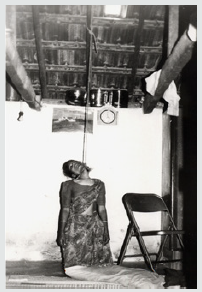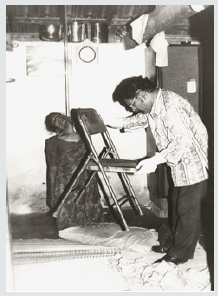Lupine Publishers | Journal of Forensic & Genetic Sciences
Abstract
Death investigation is complicated endeavours, taking an immense amount of time to take in a scene. The general rule of thumb in death investigation is that all death investigations are handled as homicide until proven otherwise. The three critical components of any death investigations are medical/social history, examination of the body and scene investigation. Sometimes in death investigation, the body posture may cause confusion or complication and difficult to explain. A death is suspicious if it is unexpected and its circumstances or cause are unexplained in the early investigation. Normally, this occurs in the context of suicide or suspected criminal activity. The following is a case report in a death scene wherein a young woman was found hanging by a rope around the neck under suspicious condition in her residence, as it was claimed to be a homicidal hanging, allegedly murdered and hanged. But the presence of dust footprint in the scene identified as suicidal hanging and solved the mystery. The fact was explained to the blood relatives in the crime scene itself by the criminalist and made them to understand. The blood relatives understood the scientific fact and accepted the forensic explanation.
Keywords:Crime Scene Investigation; Case Study; Suspicious Death; Partial Hanging; Footprint
Case report, a Real Crime Scene Investigation
Introduction
Forensic Science is an important tool for crime investigation. Scene of crime is the starting point in Forensic Science. Death investigation is complicated endeavours, taking an immense amount of time to take in a scene. The general rule of thumb in death investigation is that all death investigations are handled as homicide until proven otherwise. The three critical components of any death investigations are medical/social history, examination of the body and scene investigation. Sometimes in death investigation, the body posture may cause confusion or complication and difficult to explain. A death is suspicious if it is unexpected and its circumstances or cause are unexplained in the early investigation. Normally, this occurs in the context of suicide or suspected criminal activity.
Hanging or self-suspension is a form of ligature strangulation where the pressure is produced by the weight of the body itself [1]. The incidence of hanging cases differs as per the variation in the community, geographical location and socio-economic condition [2]. Crime scenes contain physical evidence that is pertinent to a criminal investigation. Physical evidence is any and all subjects that can establish that a crime has been committed or can provide a link between a crime and its victim or perpetrator. The successful crime investigation depends upon the recognition, collection and analysis of various kinds of evidence [3]. Footprint is a valuable physical evidence found mostly in burglary and violent crime scenes, left by the perpetrators. But some of the investigators have underestimated the value of footprint evidence and neglected to collect this evidence during crime scene search [4,5]. In Asian countries like India, Thailand, Malaysia and Indonesia, people in the rural area are still walk barefooted [6]. Researchers have proved that footprint may be used to estimate stature [7,8], body weight [9,10] and sex [11] and to solve the crime. The present case report is unique and rare case of suspicious death, wherein the manner of death (suicide or homicide) was identified in the death scene itself through footprint. Later the autopsy examination confirmed the footprint findings.
Case Study Report
A village woman aged about 25 years was allegedly murdered and hanged the body and the body was found hanging partially by a rope around her neck under suspicious condition in her residence. A case was registered by the police under section “Suspicious Death” and requisitioned the service of the field criminalist (the corresponding author while as field criminalist in India) to visit the death scene and assist the investigation. The field criminalist visited the death scene and examined the scene. The body was found hanging in kneeling position as shown in Figure 1.
The house was tiled roof with wooden rafters and the body was found hanging in kneeling position. As an Indian Tamil woman, she worn saree, blouse and bangles. The rope was made of coconut fibre, normally available in all shops for the regular domestic and other uses. The position of the knot was on the left side with prominent ligature mark but non-continuous in the neck. The body did not show any injuries or bleeding but noticed faecal discharge. No struggling mark was noticed. A metal folding chair was found near the dead body and examination of chair showed the presence of right dust footprint on the seat (Figure 2). In general, before hanging, one end of rope should be tied on the wooden rafter of the roof and then another end of the rope to be used to make the ligature loop for the purpose of constriction of neck. Since the rafter was high, the person should have used the folding chair to reach the rafter to tie the one end of rope. This footprint formed a vital clue and deciding factor to fix the manner of death.
Possibility of Footprint Formation
If the death was caused by suicidal hanging, the deceased should have climbed the chair to reach the rafter to tie one end of coconut fibre rope and left dust her footprint on seat surface of chair. Since the village girl used to walk barefooted in and around the house, the feet should have been stained with dust. Or else, if the death was caused by homicide, the murderer might have murdered the woman and made her hang with coconut fibre rope and masqueraded as suicidal hanging. For that, the murderer should have used the chair to reach the rafter with one end of rope and thus dust footprint of the murderer should have been transferred. Who left this dust footprint on the chair?
The dust footprint was photographed and lifted by using “electrostatic dust print lifter” and preserved for comparison analysis. The scene was photographed. Before autopsy the footprints were collected from the deceased for comparison. As the field criminalist (author) was also a “declared footprint expert”, the footprint comparison analysis was conducted in the crime scene itself and opined that the dust footprint in the chair was left by the deceased. Also, the parents have suspected a person in this regard and his footprint was also collected and footprint comparison analysis showed that the dust foot print did not match with suspected footprint. The field criminalist also showed the comparison analysis to the parents and relatives of the deceased. In the crime itself, the field criminalist explained the parents and relatives about forensic science, footprint evidence, suicidal hanging, homicidal hanging etc. and made them to understand the fact.
The body was sent to autopsy room and the Professor of Forensic Medicine also invited the field criminalist to attend the post-mortem. The autopsy examination revealed that the death was due to suicidal asphyxia, ruled out the possibility of homicide and confirmed the result findings of footprint. The field criminalist prepared a crime scene report and handed over to the investigator and the autopsy report was also received. Thus, the keen crime scene observation, recognition, evidence collection, analysis of footprint evidence and crime reconstruction at length put an end to the suspicious death of the woman, beyond any doubt and came up with truth. The whole family members had also accepted the findings.
Discussion
Hanging is one of the commonest methods of approach in case of suicidal deaths in India [12]. Hanging is a process in which the body is suspended with a ligature around the neck, which causes constriction of air passage preventing exchange of air between atmosphere & alveoli of lungs, leading to asphyxia & death. The constriction force is either the weight of the whole body or the weight of the head alone. A weight of 2Kg is enough for death in hanging [13]. The present case report is an atypical hanging since the ligature was found on the left side of neck. The ligature mark on the neck of the woman was more detectable because the coconut fibre was narrow and hard material [14]. Broad object like cloth may not produce appreciable ligature mark. In a case report, an autopsy team have reported a suicidal hanging case wherein a 42-year-old male was found hanging by plastic rope and the rope was found attached to two suspension points and the middle part of it used for the binding of neck and blood stain was present on the floor below the dead body. Crime scene examination, police investigation and autopsy supported death due to suicide [15]. Some researchers have conducted study on different types of ligature materials used to commit suicide by hanging to understand the medicolegal significance of ligature mark [16].
Conclusion
Crime scene is a treasure of information. The investigators should apply their knowledge and skill to identify the fact in the crime scene, so that the fact may be accepted by the sentencing authorities in the court. The present case report provided valuable information in a suspicious partial hanging case and highlighted the value and importance of footprint evidence. The presence of footprint is not only aiding the burglary and violent cases but also useful in complicated investigation like suspicious deaths.
Read More About Lupine Publishers Journal of Forensic & Genetic Sciences Please Click on Below Link:
https://forensic-journal-lupine-publishers.blogspot.com/



No comments:
Post a Comment
Note: only a member of this blog may post a comment.